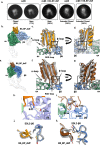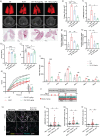De novo design of highly selective miniprotein inhibitors of integrins αvβ6 and αvβ8
- PMID: 37704610
- PMCID: PMC10500007
- DOI: 10.1038/s41467-023-41272-z
De novo design of highly selective miniprotein inhibitors of integrins αvβ6 and αvβ8
Abstract
The RGD (Arg-Gly-Asp)-binding integrins αvβ6 and αvβ8 are clinically validated cancer and fibrosis targets of considerable therapeutic importance. Compounds that can discriminate between homologous αvβ6 and αvβ8 and other RGD integrins, stabilize specific conformational states, and have high thermal stability could have considerable therapeutic utility. Existing small molecule and antibody inhibitors do not have all these properties, and hence new approaches are needed. Here we describe a generalized method for computationally designing RGD-containing miniproteins selective for a single RGD integrin heterodimer and conformational state. We design hyperstable, selective αvβ6 and αvβ8 inhibitors that bind with picomolar affinity. CryoEM structures of the designed inhibitor-integrin complexes are very close to the computational design models, and show that the inhibitors stabilize specific conformational states of the αvβ6 and the αvβ8 integrins. In a lung fibrosis mouse model, the αvβ6 inhibitor potently reduced fibrotic burden and improved overall lung mechanics, demonstrating the therapeutic potential of de novo designed integrin binding proteins with high selectivity.
© 2023. Springer Nature Limited.
Conflict of interest statement
A.R., L.S, X.D., J.L. T.S., D.B. are co-inventors on an International patent (Serial # PCT/US2020/057016) filed by University of Washington covering molecules and their uses described in this manuscript. C. O. is an employee of AstraZeneca and may own stock or stock options. M.G.C is an inventor on “Antibodies that bind integrin avb8 and uses thereof”, U.S. Patent US20210277125A1. A.R., H.B., J.C.K., M.S., M.C. and D.B. are inventors on a provisional patent (patent application serial # 63/507,646) describing the sequence and usage of αvβ8 integrins binders. A.R., L.S., J.C.K, H.B. and D.B. are co-founders of Lila Biologics and own stock or stock options in the company. All other authors declare no competing interests.
Figures





Update of
-
De novo design of highly selective miniprotein inhibitors of integrins αvβ6 and αvβ8.bioRxiv [Preprint]. 2023 Jun 12:2023.06.12.544624. doi: 10.1101/2023.06.12.544624. bioRxiv. 2023. Update in: Nat Commun. 2023 Sep 13;14(1):5660. doi: 10.1038/s41467-023-41272-z. PMID: 37398153 Free PMC article. Updated. Preprint.
References
Publication types
MeSH terms
Substances
Grants and funding
LinkOut - more resources
Full Text Sources
Medical

